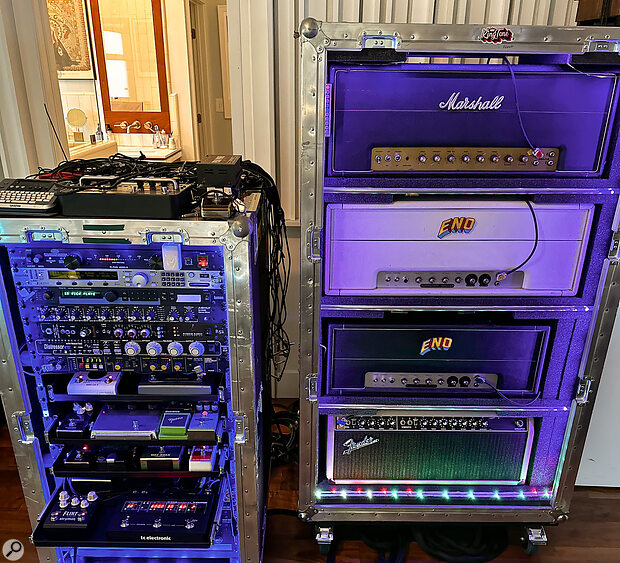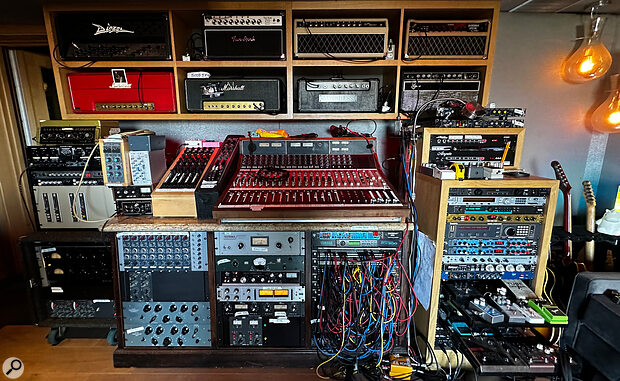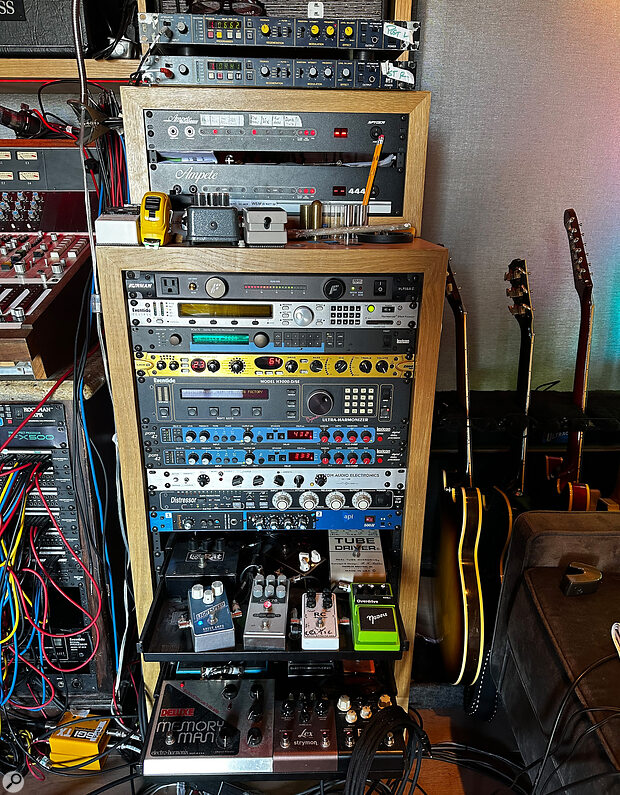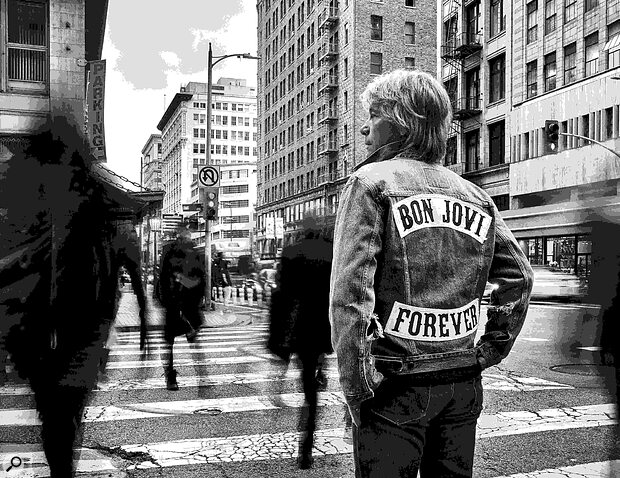 Jon Bon Jovi and John Shanks have been working together now for more than 20 years.Photo: Lise Pedersen
Jon Bon Jovi and John Shanks have been working together now for more than 20 years.Photo: Lise Pedersen
Jon Bon Jovi has stayed ahead of the pack for more than four decades, with the help of long‑term collaborators such as producer and engineer John Shanks.
In 1980, the young Jon Bon Jovi began his journey to becoming one of the world’s biggest rock stars by running errands at New York’s Power Station recording studio, operated by his cousin Tony Bongiovi. Observing stars ranging from Queen to Chic at close quarters gave Bon Jovi an education and insight into the world of recording that would hold him in good stead in the years that followed.
“One of the important lessons I learned in those early years was that there was nothing to fear about the red button,” Jon Bon Jovi recalls today. “It’s there for you to experiment, so that you are able to try another take and another idea. When I started in the studio, I didn’t know what a comped vocal was. I remember saying to an engineer in 1980, ‘I’m sorry if you want me to sing it four or five times,’ and he was like, ‘No, that’s how you do it.’ And I was like, ‘Oh! I thought everything was off the floor?’ So, I couldn’t have been so green, and though I never became an actual engineer, I did learn and understand what life was like making a record and how you went about it. Like, how an arrangement worked, how getting tones worked, and that it all mattered when it came to making a record.
“Having been in the room with the masters and their assistants too, like Bob Clearmountain, Neil Dorfsman, Scott Litt and Jason Corsaro, who were all there at the start of the Power Station, benefited me greatly too. And I had a band, and the band needed to be recorded, and the assistants and the lower‑ranking engineers also needed time behind the board. All these guys were on staff at the Power Station and were making a flat $250 a week to record whoever was there, so none of them were getting points or making big bucks working for the rock star band. So, I had the benefit of going in late at nights and on weekends while they were learning their craft, and I was learning mine.”
Bon Jovi also credits those early years learning the craft in the confines of the recording studio with his approach to production, something which came to the fore when he shared production duties with Canadian rocker Aldo Nova for his 1991 album Blood On The Bricks, on which Bon Jovi played a major role in helping shape Nova’s musical vision.
“When it comes to production, it’s about how and what I am able to add to that equation and to the songs,” he says. “If I’m able to add anything to the song and it is still genuine for the artist, then that is a great gift of a producer, because it’s about helping the band create their sound, and not making the record the producer’s sound or vanity project or whatever descriptive word you want to use. So, for me, at the end of the day, a great producer is a collaborator.”
Making The Difference
Bon Jovi’s debut single ‘Runaway’ was recorded at The Power Station in 1982, with session musicians who frequented the studio. The single later won a radio competition run by a local New York radio station in search of the best unsigned group and quickly became popular on the station’s playlist, prompting the singer to assemble a group. With a line‑up secured, Bon Jovi re‑entered the Power Station to record their 1984 self‑titled debut album. Its follow‑up, 7800° Fahrenheit, appeared the following year and was their first album to be certified gold, before 1986’s Slippery When Wet brought commercial success on a massive scale.
Jon Bon Jovi credits Slippery When Wet producer Bruce Fairbairn as the catalyst in finally capturing the potential of the band on record. “The big difference between our first two records and the third one was that in our early years on those first two records, Tony Bongiovi and Lance Quinn and us were still learning the ropes,” recalls Bon Jovi. “But by the third record, we had really figured out record‑making, and Bruce facilitated that. He captured what we could do live on record that wasn’t being captured properly on the first two records.”
The experimental spirit that Bon Jovi had gleaned from his early years at the Power Station was another factor in the album’s success, particularly on the anthemic ‘Livin’ On A Prayer’, which featured a talk box, a guitar effect first popularised in the ’70s. “We were kids of the ’70s, so that was really easy and evident, but it wasn’t as prevalent as it was by the time 1986 came around,” says Bon Jovi. “Richie [Sambora] was very cognisant of Joe Walsh’s using it, and Peter Frampton of course, but it hadn’t been used or spotlighted in that way for a number of years. So, when the opportunity came up, we both were like, ‘Yeah, good idea!’”
New Jersey, which arrived in 1988, continued Bon Jovi’s upward trajectory. The grunge‑soaked ’90s were greeted with 1992’s Keep The Faith and 1995’s These Days, and the new millennium with 2000’s Crush and 2002’s Bounce. Each successive release showcased the group’s knack for writing stadium‑sized anthems whilst refining and evolving their sound.
John & Jon
In 2005, John Shanks, a producer, guitarist, and songwriter with a background in both pop and rock as well as country, came on board to assist Bon Jovi with production on the group’s ninth studio outing Have A Nice Day. Twelve years later, Shanks’ role would also expand to touring rhythm guitarist for the group.
“Working with John was a huge shift for the band, because by that point, we were ready for a change,” recalls Bon Jovi. “I think back to the Crush album and the passing of Bruce Fairbairn, who was going to get back together once again with Bob Rock and do Crush, and I remember coming home from Europe where I was doing a film and literally walking in my home, with my coat still on, and the phone was ringing. I grabbed the phone before I took my coat off to hear the news that Bruce had passed away. We had been exchanging all kinds of notes on the pre‑production for what was going to be the start of that album. We ended up doing that record myself, Richie, and a guy named Luke Ebbin, and then because of the success of ‘It’s My Life’ and that album, we used Luke one more time on Bounce and then post 9/11 we thought, ‘OK, time to move on from that.’
“And when we met John, it was a shift in everything from a production standpoint, as he brought a collaborative new sound. He was the hot kid too: producer of the year and producing all these young Michelle Branches of the era, working with Sheryl Crow and a lot of big hit records. And he was a guitar player, too, which was also really different as we hadn’t worked with a guitar player since Lance Quinn. Bruce Fairbairn was a trumpet player, so he couldn’t play guitar. Bob Rock was a guitar player too when we were making Keep The Faith, and Luke Ebbin was a bit of a keyboard player. So, when we went in the room with John, he was not only a great guitar player, but also able to collaborate in the songwriting. So, this was a first with a producer co‑writing a song together, because John could actually add something to the process, which I really loved.”
Home Cooking
“When Jon invited me to work with him and Richie [Sambora] on ‘Have A Nice Day’, that was pretty much the first song we wrote, the three of us together,” remembers Shanks today. “And it was great because Jon kind of comes from where I come from, which is kind of oldschool most of the time. I mean most of the time when we’re writing it’s just a legal pad and acoustic guitar and no bullshit, because you can’t hide behind the track or the beat or the production. And, I’m always the one in the room that’s like ‘Now, let’s go put it down.’ But Jon’s like, ‘Not yet, not ’til I cross the ‘t’s and dot the ‘i’s.’
“So, when we wrote ‘Have A Nice Day’, what was beautiful about that particular day is that once we wrote it in his kitchen, the three of us walked across the lawn and into his studio in New Jersey and spent the day recording it. We put it down just enough for us, some acoustic guitars and maybe a beat or something, just enough for Jon to sing it so then the three of us could hone the melodies and really craft the song as songwriters, making sure the key was right, and the tempo was right. And that vocal that appears on the final recorded version is from the vocal we recorded on that day when we wrote the song!
“Obviously on the final version, we later overdubbed some ‘oohs’ and ‘aahs’ and the harmonies, and tweaked a word or two, but the lightning in the bottle occurred that day, which also happened on ‘Who Says You Can’t Go Home’. When Jon gets into the zone, everyone’s emotionally connected to that moment, you’re tracking it and everyone is zoned in on that song emotionally, spiritually, whatever. He connects to the vibe of the room and so he knows what his job is and he goes out there and will just sit in the pocket, so to speak.”
“We’ve also done it every other way too,” says Bon Jovi. “Where some tracks that we have worked on prior to recording have been an idea that John might have suggested from a tracking standpoint where I’d come up with a chorus for it, others have come from out of my notebook and cassette tapes that I’ve had.”
 For initial demos, John Shanks will track scratch guitars to Logic on his ‘road rig’.
For initial demos, John Shanks will track scratch guitars to Logic on his ‘road rig’.
From The Top
When it comes to making a new Bon Jovi album, much time and energy is given to pre‑production, with Shanks demo’ing the bulk of the material in his studio. “Prior to recording an album, I will put together a demo,” Shanks explains. “A Logic template is my starting point, as it’s my go‑to writing software. There’s literally 74 things that are in that template. Everything from kick samples, drum snares, hi‑hats, closed hi‑hats, and 707 Roland drum kits. There are also bass synths, Minimoogs, synth basses, different augmented strings, weird piano sounds, winding vinyl, winding piano, analogue strings, different types of Junos... there’s just so much stuff so it allows me to start stacking everything.
“For the guitar session, once I have the structure down, I will usually check what tempo and key feels right for the song and I’ll probably do some double‑tracking using an amp or several amps from my vast amp collection that I have, from Marshall Plexis and Dumbles to Fenders and others. And it all goes into my Universal Audio rig, which has a 4x12 cabinet set up underneath my house and which is miked up with a [Shure] SM57.”
At the demo stage, Shanks also contributes scratch drum tracks. “Once I have sketched it out to a certain point, I’ll bring the session into Pro Tools, where I’ll then add real drums. On one of the drum kits I use Royers, and the other I use AKG C414s as my overheads on my kit upstairs. I have two different drum kits in the studio. There’s one that’s set up in the living room that’s more of a big rock kit and another kit downstairs in the real studio. I will use Coles 4038 ribbon mics for the overheads, a Sennheiser 421 on the toms, and an AKG D19C for the kick. I will also add a mono mic on the drums, using a D19C which is kind of what the Beatles used, and will position that either above the kit or between the kick and the snare and then compress it with a [Empirical Labs] Distressor. For the room mics, I will use Gefell UM57s along with an EMI compressor. Then I’ll Beat Detective the drums, put them on the grid and add real bass. Once that’s all done, I’ll take it to the band where it gets recorded properly.”
 John Shanks’ full‑fat guitar tracking rig is a no‑holds‑barred affair, with multiple amp heads, remote cabinet switching and some seriously tasty outboard.
John Shanks’ full‑fat guitar tracking rig is a no‑holds‑barred affair, with multiple amp heads, remote cabinet switching and some seriously tasty outboard.
The downstairs setup in the ‘real studio’ is used to record keeper guitar takes once tracking has started in earnest. “When I go downstairs I dump everything into Pro Tools, which also has another guitar rack set up, which has an ‘amp‑brary’ that holds numerous amp heads which go to all sorts of different cabinets via an Ampete switcher. I will use the switcher to assign, for example, a Marshall 50‑Watt Plexi to a 20‑Watt Greenback 4x12 or the Dumble to a certain cabinet, so I can choose what amp or cabinet du jour depending on what tone I’m after. My guitar signal goes from the API mic pre into a Distressor, which then splits the signal into two Lexicon PCM 42s and an Eventide H3000 and an Eventide Eclipse and then into a Lexicon PCM 70. And if I want to change amplifiers, I will use my Ampete guitar switcher to go to different heads and cabinets which are miked up with SM‑57s, while others are miked up with Sennheiser MD409s. And though I’m not opposed to using guitars in the box, I am more of a purist. I really like amps, whether they’re small or big amps. I just try to strive for what’s more appropriate and what I feel is right for the band.
“As for my go‑to acoustic guitar sound, it is primarily a Gibson Hummingbird or J‑45 acoustic, miked with a [Neumann] FET 47 and [UREI] LA‑3A compressor and Neve mic pre. There is something about Gibson acoustics and a FET 47 that I love and it’s just like, ‘Wow, that’s a great sound’. So, we just kind of hit on that and went with it.”
And although his own drumming helps move the demo process along, Shanks is the first to point out that the band’s actual rhythm section is crucial to the Bon Jovi sound. “The rhythm section of Tico [Torres, drums] and Hugh [McDonald, bass] is so integral to the music. I remember we were working on a little demo of something in my early days with the guys, and I played a bass just to put it down along with a little drum beat. And then Tico and Hugh came in and all of a sudden, the song came alive! They were playing on top of this track that Jon and I had been working on, and the foundation was suddenly there. Tico is one of those instinctual drummers, in the sense that he is a studio drummer. He just listens to the song, and doesn’t write anything down. He’s truly an ‘emotional in the moment’ player.”
 Ampete switchers handle the head/cab routing, with dedicated guitar effects including an API channel strip, a pair of Lexicon PCM 42 delays, a PCM 70 reverb, Eventide Eclipse and H3000 Harmonizers, and an Empirical Labs Distressor compressor.
Ampete switchers handle the head/cab routing, with dedicated guitar effects including an API channel strip, a pair of Lexicon PCM 42 delays, a PCM 70 reverb, Eventide Eclipse and H3000 Harmonizers, and an Empirical Labs Distressor compressor.
Forever & Ever
Last year saw Bon Jovi celebrate 40 years in the business, and the group’s most recent album Forever has just been given a fresh makeover. With the group unable to tour while Bon Jovi recovers from his well‑documented vocal surgery, the decision was made to invite friends to add their vocal contributions alongside Bon Jovi’s original parts.
“The truth is I wanted a little more time to be road‑ready,” admits Bon Jovi. “This is an album that we’re very proud of, and I think it’s the best Bon Jovi record since Lost Highway or at least Have A Nice Day. We love every song on it and it was a joy to make this album, but I just wasn’t ready to go and book shows post‑surgery recovery. So, I reached out to a number of friends and I said, if you guys would sing a verse here and there, it’ll give this great album another life. My focus moving forward is on the re‑release of Forever, and God willing, getting back out on the road and running that project through its life.”
Bon Jovi’s 40‑year career is a testament to the band’s enduring power and popularity. “‘Runaway’ established something that was, in retrospect, bigger and deeper than it would seem on the surface, because I already had a social consciousness in the lyric writing,” muses Bon Jovi. “It might be juvenile, but nonetheless, here’s a kid that’s talking about a runaway girl on the street while I, getting off that same bus, was the lucky one, who got to walk to the recording studio. So lyrically Bon Jovi were going to be separated from the pack. Then with Slippery When Wet, we were ready to make that record as writers, as musicians, as singers and that record became what it was. Then Keep The Faith was integral too, because the genre was getting tired and grunge had come in, yet not only did we survive, but we thrived. And Keep The Faith was a smarter record than the stuff that was considered a part of the genre that we were considered to be a part of. So we broke free of all of that, and not only did we survive, but we thrived in that early ’90s period. Of course, we reinvented the wheel again with Crush and having a hit with ‘It’s My life’ at a time when the industry looked at you 20 years on and said, ‘You’re supposed to be done now.’ And we weren’t.
Jon Bon Jovi: I’ve always figured out a way, with everybody’s help, to find that next gear. And every time along the way, I can look back and say, I knew what we were doing.
“So, we went to Nashville and had a number one country song, the first rock band ever to do that. I’ve always figured out a way, with everybody’s help, to find that next gear. And every time along the way, I can look back and say, I knew what we were doing. This is what happened and why. And I can tell you that Keep The Faith was a conscious attempt to do that. And that ‘It’s My Life’ was ultimately a conscious attempt to do that too. Going to Nashville to do Lost Highway after having a number one song, ‘Who Says You Can’t Go Home’, was me saying, ‘I know what’s next.’ And then on and on and on and on. And Forever is just the latest instalment of where we’re at. I think that the band’s legacy is set at this point, and we want to continue to make great records and not rest on previous catalogue.”
Vocal Miking
When it comes to capturing Jon Bon Jovi’s vocals, both the singer and John Shanks are particular in their choice of microphones. “From This House Is Not For Sale and through to 2020 and now this record [Forever], I’ve been using a [Shure] SM7 with Jon, as it’s a versatile mic,” asserts Shanks. “We can use it at any studio and it does a really nice thing with Jon’s vocal. Since the SM7 is not a tube mic, you can just yell into it and it has a beautiful mid that cuts, and it’s not super hyped on the top. It’s not like a [Neumann] 67 or a 47 or a 48. And the reason that we started using that mic was when we were doing This House Is Not For Sale, we were bouncing around from studio to studio and I wanted a consistency to the sound and the SM7 provided that.
“Another mic we’ve used on a lot of the records is the Neumann CMV‑3, which is one of the earliest Neumann mics. It’s kind of what the Blue [Bottle] mic was based off; those long tube ones where it comes down like a bottle mic with a big diaphragm. Sometimes, if we’re rehearsing songs or in production, and Jon’s using that mic, it becomes a sound almost, depending on how you compress it and how much you drive the mic pre.”
“The thing about that SM7 too is, historically I had a very loud voice, and the capsule would never collapse if I belted something into it,” adds Bon Jovi. “I used to like holding it by the sides of the spit pad, and just really let loose in that capsule. And it really brought a warmth to my vocal sound. But I’ve also used everything from Neumann U87 to a Sony C800G that I’ve had for years that comes with a power unit.”
“And the Sony’s way brighter too,” interjects Shanks. “It’s very pop, so it’s used on a lot of pop vocals, due to it being super clean, and super bright. They usually pair that with a Tube‑Tech parametric EQ which is really clean, too.”

